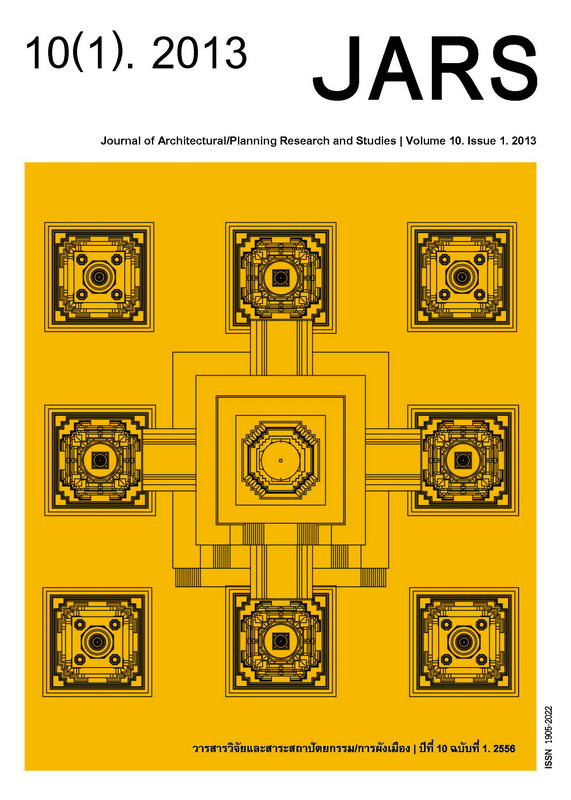Sustainability via Adaptability: Learning from the Traditional Thai House’s Built-for-Change Architecture
Main Article Content
Abstract
Adaptive reuse plays an important role in safeguarding the traditional Thai house, or Ruen Thai, byappropriately converting the time-honored architectural fabrics to efficiently fulfill new requirements and ensuretheir practicality and compatibility with today’s context. This paper studies converted traditional Thai houses,and addresses embedded adaptive qualities that facilitate physical and functional modifications. The qualitiesnot only contribute to the conservation of Ruen Thai, but their potential applications in contemporary designscan also encourage environmentally sustainability. Revealed through structures undergone adaptive reuseprocedure, the adaptability is articulated via five key attributes: the prefabricated structure that allows dismantling,relocation and reassembly of components; the modularity and neutrality of house units that retain the compoundintegrity; the interconnectivity of the central terrace that accommodates an addition of house units; the use ofa single room for a single function that provides flexibility of conversions; and, the potential unoccupied areason the ground floor, the veranda and the terrace that can be enclosed for additional functional spaces. Thebuilt-for-change qualities enhance the architecture’s performance and prolonging its operational lifetime, whileacknowledging creative changes. At the same time, the adaptability allows a reuse of existing resources and areduction of extra consumptions and investments needed for new constructions.
Downloads
Article Details

This work is licensed under a Creative Commons Attribution-NonCommercial-NoDerivatives 4.0 International License.
All material is licensed under the terms of the Creative Commons Attribution 4.0 International (CC-BY-NC-ND 4.0) License, unless otherwise stated. As such, authors are free to share, copy, and redistribute the material in any medium or format. The authors must give appropriate credit, provide a link to the license, and indicate if changes were made. The authors may do so in any reasonable manner, but not in any way that suggests the licensor endorses you or your use. The authors may not use the material for commercial purposes. If the authors remix, transform, or build upon the material, they may not distribute the modified material, unless permission is obtained from JARS. Final, accepted versions of the paper may be posted on third party repositories, provided appropriate acknowledgement to the original source is clearly noted.
References
Bloszies, C. (2012). Old buildings, new designs: Architectural transformations. New York: Princeton Architectural Press.
Brand, S. (1994). How buildings learn: What happens after they’re built. New York: Penguin Books.
Chaichongrak, R. (2000). Ruen Thai Doem [The traditional Thai house]. Bangkok, THailand: The Association of Siamese Architect.
Chaichongrak, R., Nil-athi, S., Panin, O. & Posayanonda, S. (2002). The Thai house: History and evolution. Bangkok: Asia Books.
Cohen, Y. A. (1968). Culture as adaptation. In Man in adaptation: The cultural present. Chicago: Aldine Publishing Company.
Fitch, J. M. (1995). Historic preservation: Curatorial management of the built world. Charlottesville: University Press of Virginia.
Gause, J. A. (1996). New uses for obsolete buildings. Washington, D.C.: Urban Land Institute.
Horayangura, V. (2009). In search of sustainable paradigms for conservation and development based on underlying convergent/divergent conceptions. Journal of Architectural/Planning Research and Studies, 6(3), 3-21.
Jacobs, J. (1992). The death and life of great American cities. New York: Vintage Books.
Kronenburg, R. (2007). Flexible: Architecture that responds to change. London: Laurence King Publishing.
Murtagh, W. J. (1997). Keeping time: The history and theory of preservation in America. New York: John Wiley & Sons.
Pansoonthorn, K. (1990, October 26). Is Thai-style Home Facing Extinction? The Nation, pp. F1, F3.
Piromya, S. et al. (1995). Thai houses. Bangkok, Thailand: The Mutual Funds Public Company.
Ramasoot, S. (2008). Dismantle, reassemble and modify: An adaptive reuse of the traditional Thai house. Ph.D. Dissertation, University of Pennsylvania.
Ramasoot, S. (2009). Tradition reevaluated: Contemporary challenges of the traditional Thai house and their treatments via modern adaptations. Old-new: Rethinking architecture in Asia. Proceedings of the 8th Silpakorn Architectural Discourse 2009 Symposium, 8, 219-237.
Robert, P. (1989). Adaptations: New uses for old buildings. New York: Princeton Architectural Press.
Rujivacharajul, V. (1999). Ruen Thai: A Rediscovery of Thai Cultural Identity? Proceedings of the 7th International Conference on Thai Studies, Amsterdam, the Netherlands, 4-8 July 1999.
Vale, B. & Vale, R. (1991). Green architecture: Design for a sustainable future. London: Thames and Hudson.
Yeang, K. & Spector, A. (2011). Green design: From theory to practice. London: Black Dog Publishing.
Zeiher, L. C. (1996). The Ecology of architecture: A complete guide to creating the environmentally conscious building. New York: Whitney Library of Design.

